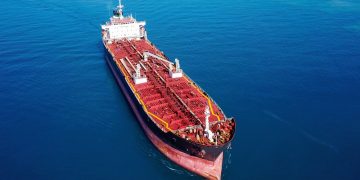The National Transportation Safety Board (NTSB) has issued an investigation report regarding a deteriorated bollard led to a mobile offshore drilling unit breaking away and colliding with a cargo vessel in Pascagoula, Mississippi last year. The breakaway resulted in nearly $5 million in damages.
On March 12, 2022, about 0020 local time, the mobile offshore drilling unit VALARIS DS-16 was in layup status at the ST Engineering Halter Marine and Offshore Shipyard in Pascagoula, Mississippi, when it broke away from the dock, drifted across the Bayou Casotte channel, and collided with the bulk cargo vessel Akti moored at the Chevron Refinery dock no.6. There were no injuries reported for the 164 crewmembers and personnel on board the VALARIS DS-16 or the 22 crewmembers on board the Akti, and there was no pollution reported. The total damage resulting from the breakaway was estimated at $5 million.
Analysis
Before the VALARIS DS-16 arrived in Pascagoula, the vessel’s operating company completed a mooring analysis, which identified the critical components in the mooring arrangement and sustained wind speed limitations for the eight principal wind directions. The mooring analysis considered the loss of a single mooring line and calculated critical components (the analysis did not consider the unlikely event of losing a bollard).
According to the mooring analysis, because the VALARIS DS-16 would be moored with its bow facing a northerly direction (012˚), the vessel would be most vulnerable to wind forces from the west, which would exert pressure directly on the port side of the vessel (winds from the east would have exerted pressure on the starboard side, blowing the vessel against the dock). The mooring analysis determined this vulnerability and calculated the limiting sustained wind speed to 34 knots with northwest winds and 60 knots with north winds. The vessel’s crew was directed to drop anchor and call tugs alongside for assistance if they expected the limitations to be exceeded.
Conclusions
The National Transportation Safety Board determines that the probable cause of the breakaway of the VALARIS DS-16 from the ST Engineering Halter Marine and Offshore Shipyard dock and the subsequent collision with the cargo vessel Akti was the failure of one of the shipyard’s mooring bollards—which had been modified to increase its height to accommodate more lines—used to secure the VALARIS DS-16’s bow mooring lines to a pier, during a cold front with strong winds.
Lessons Learned
Bollard Inspections
As a result of continuing increases in vessel size and sail area, bollards that were previously sufficient may not have adequate capacity to moor larger vessels. There are currently no US Coast Guard or Occupational Safety and Health Administration regulatory requirements for facilities to inspect and verify loading capacities of bollards at shoreside facilities. Bollards and associated pierside mooring equipment are vital equipment that must be capable of withstanding the tremendous forces that large vessels exert on them. Due to their exposure to seawater, bollards and associated pierside mooring equipment are also at high risk for corrosion, which can significantly affect service life. The Coast Guard has recommended that facility owners and operators develop routine inspection programs for bollards and other mooring equipment.


































































